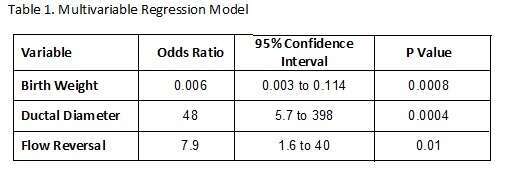
Clinical course of the Hemodynamically Insignificant Ductus Arteriosus
Background: Early targeted therapeutic closure is increasingly recommended for the most hemodynamically significant patent ductus arteriosus (hsPDA) in premature neonates. Few reports have focused on what to expect from the open but hemodynamically insignificant ductus arteriosus (hisPDA) during the early days of life.
Objective: To assess the clinical course of the hisPDA in the first week of life in premature neonates.
Methods: We reviewed the echocardiograms of all infants
Results: 75 (46%) of the 164 preterm infants identified had hisPDA`s identified on their initial echocardiogram and 30 (40%) of these subsequently progressed to hsPDA`s and therapeutic attempts at closure. Although all were initially classified as hisPDA, those ducts which progressed to hemodynamic significance were different from early on [Table 1]. The early echocardiographic parameters best associated with subsequent progression to significance were an increased ductal diameter (1.81+/-0.77 vs 1.21+/-0.44mm.; p<0.001) and the presence of diastolic flow reversal in the distal descending aorta (p=0.01). The incidence of chronic lung disease/death, sever necrotizing enterocolitis and severe intraventricular hemorrhage increased progressively from those with a closed duct to those with hisPDA to those with hsPDA [Table 2].



Powered by Eventact EMS